With Video Analytics, enhanced notifications are sent with thumbnail images showing people, vehicles, and animals. Advanced detection rules can also be used to draw virtual tripwires across driveways and virtual fenced-in zones for a property. Email and text notifications can be sent whenever:
- A vehicle pulls into the driveway or a person walks up the front steps
- Anyone loiters in a specific zone of a property
- A pet jumps up on the sofa or enters an off-limits flowerbed
- A child leaves the yard or someone drives off at night
Video Analytics can spot what is important, even if there is a lot going on.
Camera setup
- Position
- Position the camera 8-16 feet above the ground.
If the camera is re-positioned, recreate all of the rules and re-calibrate the camera if the camera supports calibration. For more information about which cameras must be calibrated, see Calibrate a device for Video Analytics.
- Position the camera 8-16 feet above the ground.
- Angle
- Angle the camera downward between 30°-60°. The horizon line should be as level as possible with the ground at the bottom of the image.
This recommended angle provides for an ideal field of view while avoiding clouds and trees. Video Analytics is designed to work with an angled-down perspective; not horizontal, and not top-down.
- Angle the camera downward between 30°-60°. The horizon line should be as level as possible with the ground at the bottom of the image.
- Distance
- Targets should not be farther than 25 feet away (15 feet at night), and the entire target should be visible inside the camera’s field of view.
- Environment
- Be aware of any bright lights (i.e., motion-triggered floodlights) near the camera that may attract insects or affect exposure and IR settings. Mount the camera in such a way that a vehicle’s headlights do not shine directly into the camera.
- Avoid reflective surfaces (i.e. overhangs/eaves, walls, etc) that will reflect IR lights at night and make it difficult to see objects further away as reflective surfaces become overexposed.
What to Record
Video Analytics detects and classifies people, animals, and vehicles. Position the camera with a view that would be interesting.
Recommended Camera locations
- Overlooking a driveway
- Overlooking a front porch or wherever packages are dropped off
- An area of interest around a yard, where kids or animals are sometimes seen
- Indoor entryways, exit ways, or hallways of interest
- Areas with constant or uninteresting motion (e.g., roads with regular vehicle movement, trees constantly swaying in the wind, etc.)
- Pointing cameras out a window, as screen interference and reflections cause Video Analytics performance issues
Create a Video Analytics Rule
Video Analytics rules can be configured using the Alarm.com Website or Fluent app.
Note: It is possible to create up to three Video Analytics rules on the same camera. Additionally, ground zones and tripwires can overlap.
Add the Video Analytics rule
Using the Alarm.com Website:
- Log into the Alarm.com Website.
- Click
Video.
- Click Recording Rules.
- Click Add Rule.
- In the New Video Recording Rule window, select Video Analytics.
Using the Fluent app:
- Log into the Fluent app.
- Tap
Video.
- Tap
.
- Tap Recording Rules.
- Tap +Add New Rule.
- Tap Video Analytics.
Select the rule type
- Click to select the desired camera. If the camera needs to be calibrated, the user is directed to the Calibrate page. For more information about camera calibration, see Calibrate a device for Video Analytics.

- In Select Type, click to select the rule type.
- Click Tripwire when a target is likely to cross through the camera’s field of view or when objects enter or exit an area (e.g., a car pulling into or backing out of a driveway).

- Click Ground Zone when a target is likely to linger in the camera’s field of view (e.g., a person delivering a package on the front porch).

- Click Tripwire when a target is likely to cross through the camera’s field of view or when objects enter or exit an area (e.g., a car pulling into or backing out of a driveway).
- If the camera has Video Motion Detection (VMD) recording rules set up, they must be deleted before setting up a Video Analytics rule. When prompted with the following warning, click OK to continue.
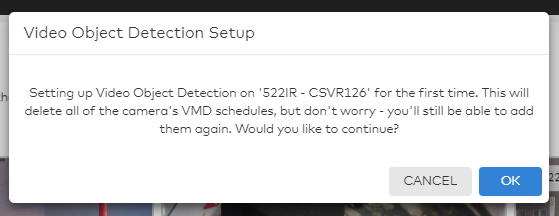
- Click Next.
Select the camera scene
- In Scenery, click to select Indoors or Outdoors based on where the camera is installed. The camera should be marked outdoors if it will be exposed to rain, snow, spider webs, or moving trees and set to indoors if in a controlled outdoor environment (e.g., a screened-in porch).
Note: This selection must be the same across all recording rules associated with a specific camera.
Use the Minimum Object Detection Size slider to adjust how small an object can be and still trigger a recording. It is recommended to keep this at its suggested value upon initial rule creation.Very Large captures the fewest recordings only of the largest objects, and Very Small captures the most recordings including large and small objects.
Note: Certain video devices have a calibration process that replaces the Minimum Object Detection Size setting. Minimum Object Detection Size will not appear on this page for those cameras. For more information about the calibration process, see Calibrate a device for Video Analytics.
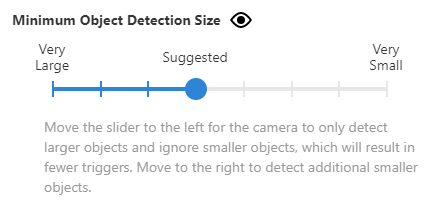
- Click Next.
To configure a Ground Zone rule:
Skip this section if Tripwire was chosen during rule type selection.
- In the Rule Name field, enter a name for the recording rule.
- Click and drag the corners of the shape to cover only the ground where the target’s feet will be. To clear the current area of interest and restart, click Clear ground zone.
- Click and hold inside the shape to move it around without changing its shape.
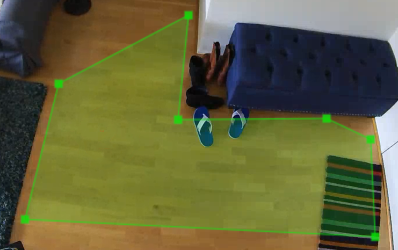
- Click and hold inside the shape to move it around without changing its shape.
- Using the Duration Inside Area of Interest dropdown menu, select the desired time an object needs to stay inside the Ground Zone to trigger a recording.
To configure a Tripwire rule:
Skip this section if Ground Zone was chosen during rule type selection.
- In the Rule Name field, enter a name for the recording rule.
- Click and drag the Tripwire to cover only the ground where the target's feet cross. The arrow determines which direction the object must be moving to trigger a recording. To clear the current Tripwire and restart, click Clear Tripwire.
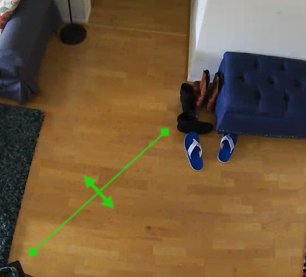
- Customize the direction of movement to be recorded:
- In Direction, click Switch directions to switch the direction of the movement to capture.
- Click to select Both Directions to record when an object crosses the Tripwire regardless of which direction it is moving.
To configure schedules, exceptions, and notifications for the rule:
- Using the Set Minimum Delay Between Clips dropdown menu, select the desired time frame. This setting determines how long the camera must wait after recording a clip to trigger another recording.
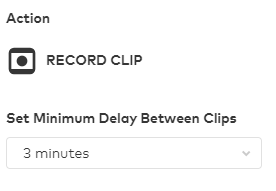
- In The Rule will run..., click to select At all times or Only during the following times.
- If Only during the following times is selected:
- Click to select the days of the week to record on.
- Using the Begin dropdown menu, select the time for the recording rule to start.
- Using the End dropdown menu, select the time for the recording rule to stop.
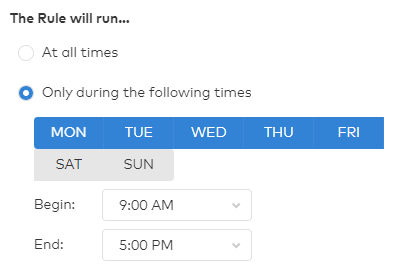
- If Only during the following times is selected:
- In Except when..., click to select any available exceptions that turn the rule off regardless of the schedule. Options depending on the equipment include: the panel is armed away, the panel is armed stay, and Geo-Device is inside a specified Geo-Fence.
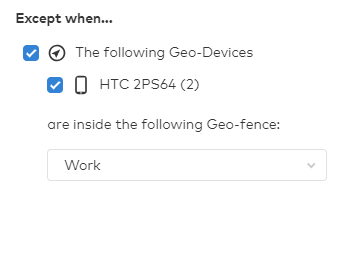
- In Send notification for clips containing..., click to select the types of clips that the user wants to be notified about. The camera records and uploads all motion it detects but only sends a notification to the user based on the selected notification options.
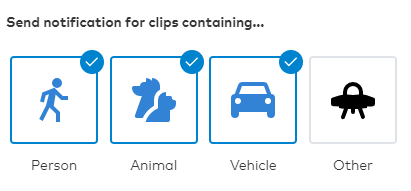
Note: Clips included in the Other category are when the camera detects an object but is unable to determine which type of object it is.
- Click to select the desired notification recipients. It is recommended to use push notifications to a phone using the dropdown option to attach a thumbnail.
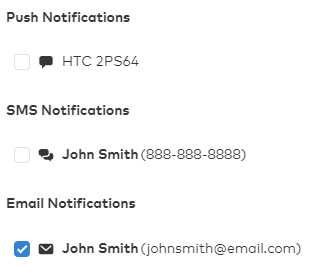
To configure light automation for the rule:
Camera-driven light automation rules require Lights to be enabled on the customer's service package along with at least one Z-Wave light device enrolled on the account. If these requirements are met, the Light Automation section appears toward the bottom of the Video Analytics Rule.
Note: Lights cannot be enabled during a time when the Video Analytics rule is not set to record (e.g., if a tripwire rule is drawn on a driveway and set to record only at night, lights cannot be set to turn on during the daytime because no clip would have been recorded).
- Using the Turn on selected lights for dropdown menu, select how long the lights should turn on for.
- Click to select which lights are to be automated by the rule.
- In Automate my light(s) when following triggers an event, click to select which events should turn on the lights when triggered.
- In During these time frames, click to select At all times, Only during the following times, or Only after sunset.
- If Only during the following times is selected:
- Click to select which days of the week on which to record.
- Using the Begin dropdown menu, select the time for the recording rule to start.
- Using the End dropdown menu, select the time for the recording rule to stop.
- If Only during the following times is selected:
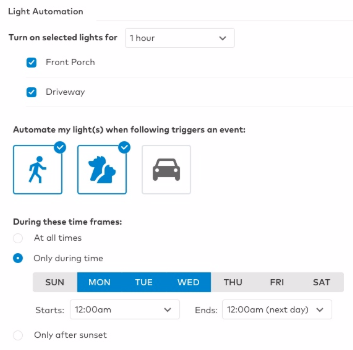
To ensure rule accuracy
- Avoid intersecting tripwires or overlapping ground zones with objects that are prone to movements, such as trees, bushes, or other objects that move in the wind.
- Only draw the rule where the feet or wheels of an object should cross.
- Do not increase the size of the loiter zone or tripwire to cover the whole of the target.
- Do not include furniture, walls, trees, or other structures in the rule/selection.
- After observing what the rule detects over a few days, consider adjusting either the Minimum Object Detection Size slider or the camera calibration.
- When adjusting the Minimum Object Detection Size slider:
- Increasing the minimum object size can reduce false detection.
- Decreasing the minimum object size can detect smaller targets.
- When adjusting the Minimum Object Detection Size slider:
View uploaded video clips
To view video clips using the Alarm.com Website
- Log into the Alarm.com Website.
- Click Video.
- Click Saved Video Clips.
- Only clips with a valid person, vehicle, or animal classification appear here by default.
- To view clips classified as Other:
- Using the dropdown menu next to the date pickers, select Other. To only show video clips classified as Other, deselect all other items in the dropdown menu.

- Click Search.
- Using the dropdown menu next to the date pickers, select Other. To only show video clips classified as Other, deselect all other items in the dropdown menu.
- To view clips classified as Other:
- To play a clip:
- In Gallery View, hover over the desired clip, then click
 Play.
Play. - In List View, click the desired clip's Clip Description.
Note: Clips that include pre-trigger recording start playing at the moment the motion is detected instead of the beginning of the clip.
- In Gallery View, hover over the desired clip, then click
To view video clips using the Fluent app:
- Log into the Fluent app.
- Tap
.
- Tap
Video.
- Tap Saved.
- Only clips with a valid person, vehicle, or animal classification appear here by default.
- To view clips classified as Other:
- Tap
.
- In Object Detection, tap Other. To only show clips classified as Other, deselect all other items in Clip Trigger.
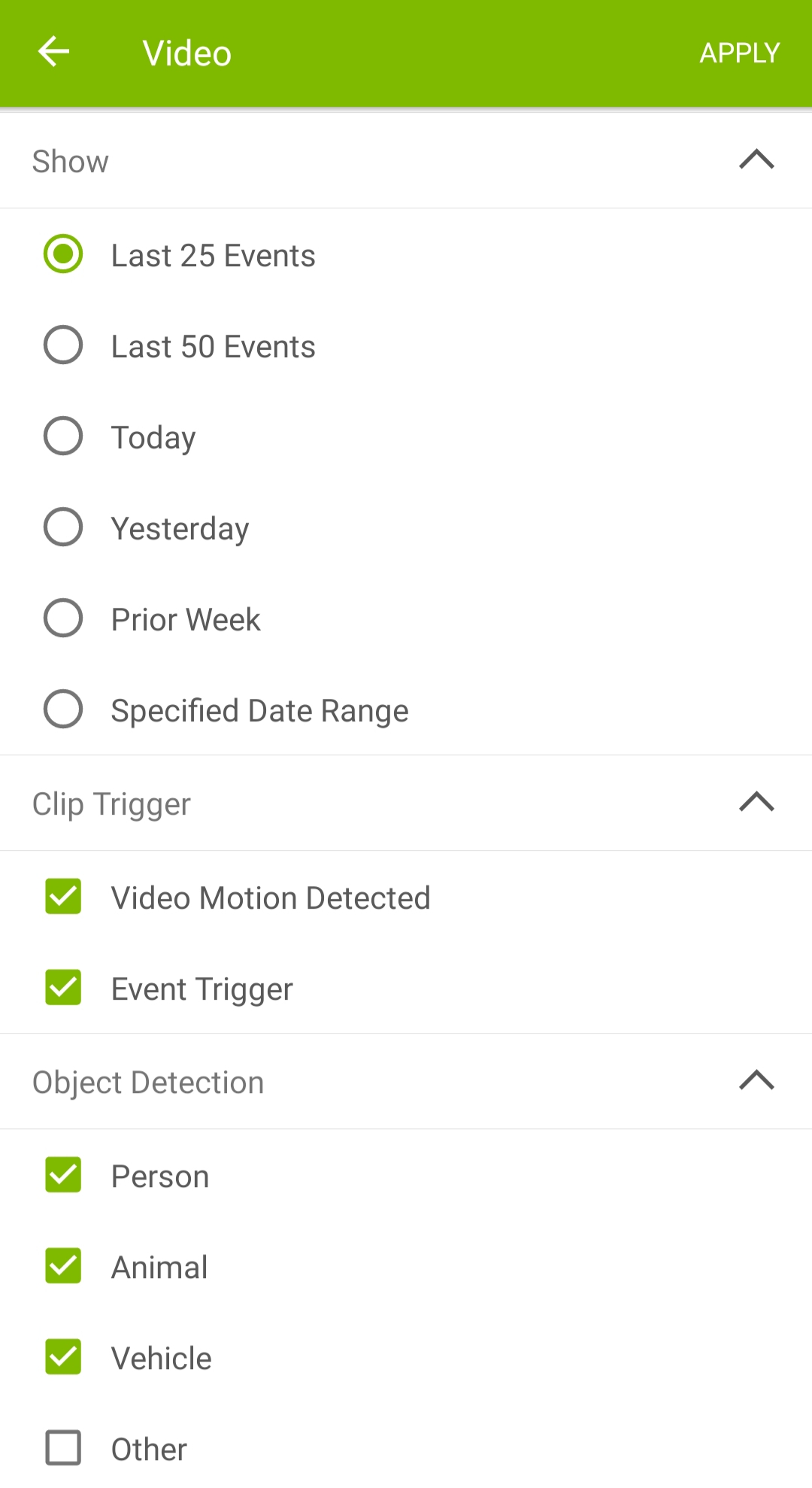
- Tap Apply.
- Tap
- To view clips classified as Other:
- Tap
.
Note: Clips that include pre-trigger recording start playing at the moment the motion is detected instead of the beginning of the clip.

.png)


